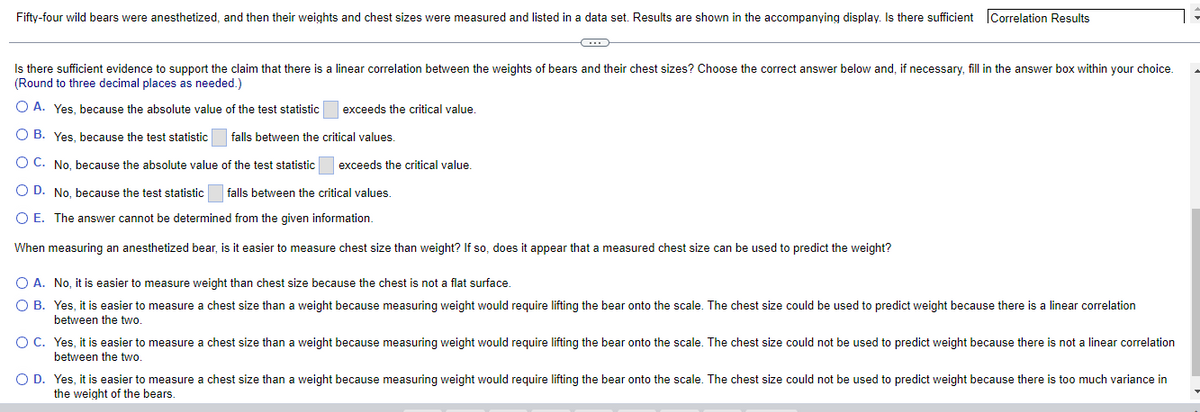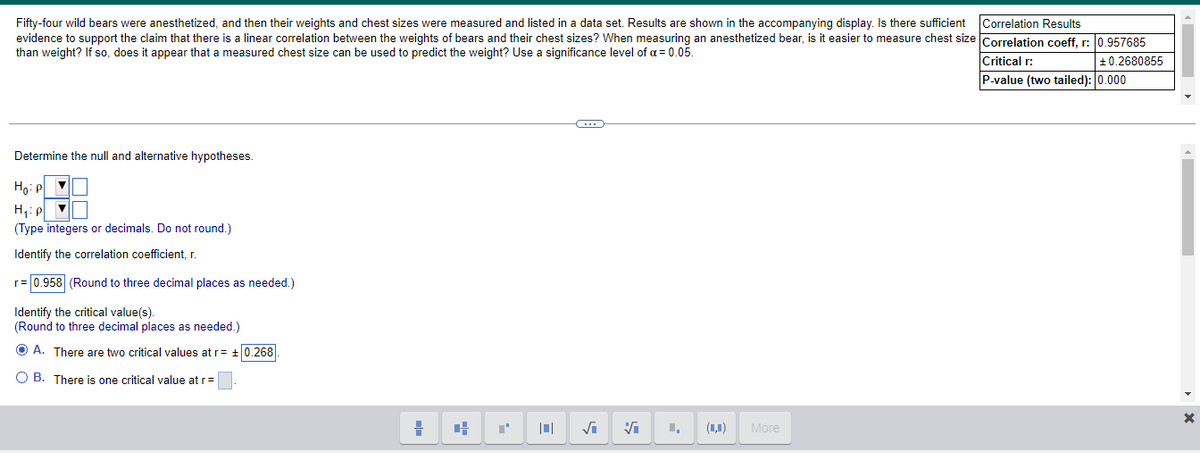Fifty-four wild bears were anesthetized, and then their weights and chest sizes were measured and listed in a data set. Results are shown in the accompanying display. Is there sufficient Correlation Results evidence to support the claim that there is a linear correlation between the weights of bears and their chest sizes? When measuring an anesthetized bear, is it easier to measure chest size Correlation coeff, r: 0.957685 than weight? If so, does it appear that a measured chest size can be used to predict the weight? Use a significance level of α=0.05. +0.2680855 Critical r: P-value (two tailed): 0.000 Determine the null and alternative hypotheses. Ho: P H₁: P (Type integers or decimals. Do not round.) Identify the correlation coefficient, r. r = 0.958 (Round to three decimal places as needed.) Identify the critical value(s). (Round to three decimal places as needed.) A. There are two critical values at r= +0.268 OB. There is one critical value at r=
Fifty-four wild bears were anesthetized, and then their weights and chest sizes were measured and listed in a data set. Results are shown in the accompanying display. Is there sufficient Correlation Results evidence to support the claim that there is a linear correlation between the weights of bears and their chest sizes? When measuring an anesthetized bear, is it easier to measure chest size Correlation coeff, r: 0.957685 than weight? If so, does it appear that a measured chest size can be used to predict the weight? Use a significance level of α=0.05. +0.2680855 Critical r: P-value (two tailed): 0.000 Determine the null and alternative hypotheses. Ho: P H₁: P (Type integers or decimals. Do not round.) Identify the correlation coefficient, r. r = 0.958 (Round to three decimal places as needed.) Identify the critical value(s). (Round to three decimal places as needed.) A. There are two critical values at r= +0.268 OB. There is one critical value at r=
Glencoe Algebra 1, Student Edition, 9780079039897, 0079039898, 2018
18th Edition
ISBN:9780079039897
Author:Carter
Publisher:Carter
Chapter10: Statistics
Section10.4: Distributions Of Data
Problem 19PFA
Related questions
Question

Transcribed Image Text:Fifty-four wild bears were anesthetized, and then their weights and chest sizes were measured and listed in a data set. Results are shown in the accompanying display. Is there sufficient Correlation Results
Is there sufficient evidence to support the claim that there is a linear correlation between the weights of bears and their chest sizes? Choose the correct answer below and, if necessary, fill in the answer box within your choice.
(Round to three decimal places as needed.)
O A. Yes, because the absolute value of the test statistic
exceeds the critical value.
OB. Yes, because the test statistic falls between the critical values.
exceeds the critical value
O C. No, because the absolute value of the test statistic
O D. No, because the test statistic falls between the critical values.
O E. The answer cannot be determined from the given information.
When measuring an anesthetized bear, is it easier to measure chest size than weight? If so, does it appear that a measured chest size can be used to predict the weight?
O A. No, it is easier to measure weight than chest size because the chest is not a flat surface.
O B. Yes, it is easier to measure a chest size than a weight because measuring weight would require lifting the bear onto the scale. The chest size could be used to predict weight because there is a linear correlation
between the two.
O C. Yes, it is easier to measure a chest size than a weight because measuring weight would require lifting the bear onto the scale. The chest size could not be used to predict weight because there is not a linear correlation
between the two.
O D. Yes, it is easier to measure a chest size than a weight because measuring weight would require lifting the bear onto the scale. The chest size could not be used to predict weight because there is too much variance in
the weight of the bears.

Transcribed Image Text:Fifty-four wild bears were anesthetized, and then their weights and chest sizes were measured and listed in a data set. Results are shown in the accompanying display. Is there sufficient Correlation Results
evidence to support the claim that there is a linear correlation between the weights of bears and their chest sizes? When measuring an anesthetized bear, is it easier to measure chest size Correlation coeff, r: 0.957685
than weight? If so, does it appear that a measured chest size can be used to predict the weight? Use a significance level of a = 0.05.
Critical r:
+0.2680855
P-value (two tailed): 0.000
C
Determine the null and alternative hypotheses.
Ho: P
H₁:p
(Type integers or decimals. Do not round.)
Identify the correlation coefficient, r.
r= 0.958 (Round to three decimal places as needed.)
Identify the critical value(s).
(Round to three decimal places as needed.)
ⒸA. There are two critical values at r= ± 0.268
O B. There is one critical value at r=
More
H C
√i
Vi
(II)
➤X
Expert Solution
This question has been solved!
Explore an expertly crafted, step-by-step solution for a thorough understanding of key concepts.
Step by step
Solved in 2 steps

Recommended textbooks for you

Glencoe Algebra 1, Student Edition, 9780079039897…
Algebra
ISBN:
9780079039897
Author:
Carter
Publisher:
McGraw Hill

Big Ideas Math A Bridge To Success Algebra 1: Stu…
Algebra
ISBN:
9781680331141
Author:
HOUGHTON MIFFLIN HARCOURT
Publisher:
Houghton Mifflin Harcourt

Glencoe Algebra 1, Student Edition, 9780079039897…
Algebra
ISBN:
9780079039897
Author:
Carter
Publisher:
McGraw Hill

Big Ideas Math A Bridge To Success Algebra 1: Stu…
Algebra
ISBN:
9781680331141
Author:
HOUGHTON MIFFLIN HARCOURT
Publisher:
Houghton Mifflin Harcourt